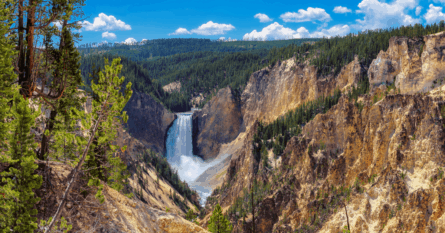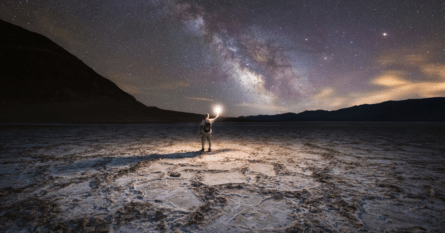Estimated reading time: 13 minutes
This Earth Day let’s celebrate the planet by exploring some of the world’s most iconic national parks while also supporting conservation efforts.

National parks showcase some of the most awe-inspiring natural landscapes on our planet and provide a unique window into the diversity of our flora and fauna. In this article, we’ll embark on a global journey to some of the most stunning national parks and delve into their ecological significance. Along the way, we’ll also share some tips on how to enjoy these parks in a sustainable and responsible manner, ensuring that we can all contribute to the vital conservation efforts that help to safeguard these treasures for future generations.
Banff National Park, Canada
Banff National Park is one of Canada’s oldest national parks and a true gem of the Canadian Rockies. With an area of 6,641 square kilometers, it’s the perfect place to explore the picturesque scenery, turquoise lakes, and abundant wildlife that the region is known for. Additionally, Banff National Park is a designated UNESCO World Heritage Site within the Canadian Rocky Mountain Parks, highlighting its exceptional natural beauty and significance.

For those seeking breathtaking views, Banff National Park won’t disappoint. Its turquoise lakes, including Lake Louise and Moraine Lake, are among Canada’s most photographed natural attractions. Fed by glacial meltwater, these lakes are simply stunning. You can take boat tours or hike to viewpoints for incredible panoramic views.
The park has a diverse range of wildlife such as grizzly bears, black bears, elk, moose, wolves, and mountain goats. Visitors have the opportunity to spot these animals in their natural habitats by taking guided tours or hiking on the park’s numerous trails. The park’s main town, Banff, also offers a wide variety of activities, from shopping and dining to hot springs and museums.
In addition to its natural beauty, Banff National Park is vital for conservation efforts. It’s home to rare and endangered species, such as the Banff Springs snail and the wolverine, and is also a designated Biosphere Reserve. Visitors should respect the park’s rules and regulations, including staying on specific trails and protecting wildlife habitats.
To minimize your impact on the environment, you can choose eco-friendly accommodations and transportation options. The park has a range of lodges and campsites, as well as shuttle buses and electric vehicle charging stations. You can also participate in conservation initiatives by volunteering or donating to local conservation organizations.
Yosemite National Park, U.S.
Located in California’s Sierra Nevada mountains, Yosemite National Park is one of the most iconic and beloved parks in the United States. Established in 1890, it covers an area of 2,800 square kilometers and is home to some of the most awe-inspiring natural scenery in the world.

At the heart of the park is the Yosemite Valley, an 11-kilometer-long glacial valley that’s surrounded by towering granite cliffs, cascading waterfalls, and lush meadows. Some of the most famous landmarks in the valley include El Capitan, a sheer rock face that’s popular among rock climbers, and Half Dome, a massive granite formation that’s recognizable around the world.
Beyond Yosemite Valley, the park contains a wide range of landscapes, from high alpine meadows to deep valleys and canyons. It’s also home to several groves of giant sequoia trees, some of which are over 3,000 years old and among the largest living organisms on earth.
But Yosemite’s importance extends far beyond its beauty and grandeur. The park is also a critical ecosystem, providing habitat for over 400 species of plants and animals, many of which are endemic to the region. Some of the most notable species include black bears, mountain lions, and the Yosemite toad, which is listed as an endangered species.
To ensure that Yosemite remains a protected area for generations to come, it’s important to visit the park responsibly and sustainably. Some tips to keep in mind include staying on designated trails to avoid damaging fragile ecosystems, respecting wildlife and their habitat by keeping a safe distance and not feeding them, and minimizing waste by packing out any trash.
If you’re visiting California and need to get around the town in style, while still respecting mother nature, then download the Blacklane app to book a 100% carbon offset ride. Since 2017, all of our rides have been automatically carbon-offset and now we’re working on offsetting all of our carbon emissions back to our founding in 2011. We also offer electric-class vehicles in Los Angeles, and electric vehicles are incorporated into our business class in many other locations.
Torres del Paine National Park, Chile
Nestled in the southern tip of the Chilean Patagonia, Torres del Paine National Park is a true nature lover’s paradise. The park spans over 1,800 square kilometers and is home to a diverse range of flora and fauna, including pumas, guanacos, Andean condors, and the iconic South American camelid, the llama.

One of the park’s most notable features is the Paine Massif, a towering mountain chain that boasts peaks up to 3,050 meters high. The massif’s most recognizable peaks are the Cuernos del Paine, a set of jagged granite peaks that are a must-see for any visitor to the park.
The park’s varied landscapes encompass grassy plains, dense forests, icy glaciers, and crystal-clear lakes. Visitors can enjoy a range of activities in the park, such as hiking, camping, and wildlife watching. The park offers a variety of hiking trails, from easy strolls to challenging treks.
One of the most popular hikes in the park is the “W” circuit, a multi-day trek that takes hikers through some of the park’s most stunning landscapes, including the Grey Glacier and the French Valley. The hike can be demanding, but the views are well worth the effort.
Serengeti National Park, Tanzania
The Serengeti National Park in Tanzania is a world-famous destination for wildlife enthusiasts. Covering an area of 14,763 square kilometers, the park is home to a remarkable variety of ecosystems, from grassy plains to riverine forests. It’s also a UNESCO World Heritage Site and has been inhabited by humans for millions of years, with evidence of early human activities still visible today.

The modern history of the Serengeti National Park began in 1921 when it was established as a game reserve by the British colonial government. It was later designated as a national park in 1951, and in 1981, it was declared a UNESCO World Heritage Site. Today, the park is perhaps best known for its diverse wildlife, including the famous “big five” (lion, leopard, elephant, buffalo, and rhino), as well as a variety of antelopes, zebras, giraffes, hyenas, and many other species.
One of the biggest draws of the Serengeti is undoubtedly the annual wildebeest migration, which is one of the world’s greatest natural spectacles. Each year, more than a million wildebeest, along with hundreds of thousands of zebras and gazelles, move across the plains in search of food and water. Witnessing this migration is an unforgettable experience, and it’s considered one of the seven natural wonders of Africa.
The Serengeti is not only a stunning wildlife destination but also a vital ecosystem that supports the survival of numerous species, both within the park and beyond. With over 3,000 lions, the largest concentration in Africa, as well as significant populations of cheetahs, leopards, and other predators, the park’s grasslands sustain enormous herds of herbivores that, in turn, support carnivores. Therefore, the Serengeti ecosystem is rightfully known as the “heartbeat of Africa.”
Kruger National Park, South Africa
Kruger National Park in South Africa is one of the oldest and most famous national parks in Africa. With an impressive area of over 19,000 square kilometers, the park is home to some of the most iconic wildlife in Africa, including lions, leopards, elephants, buffalos, and rhinos as well as cheetahs, hyenas, giraffes, zebras, and more. The park’s history dates back to 1898 when it was established as a protected area to preserve the region’s dwindling wildlife populations.

One of the most popular attractions in Kruger National Park is the opportunity to go on safari drives and spot some of the incredible wildlife. The park offers a range of tours, from self-drive safaris to guided walking tours, allowing visitors to explore the park’s diverse ecosystems, from savannah to forests and rivers. It’s important to follow the park’s rules and regulations during these tours, such as staying on the designated roads and not getting out of the vehicle in certain areas.
Kruger National Park is not only a haven for wildlife, but also a rich cultural site with evidence of human activity dating back over a million years. You can discover the fascinating history of the indigenous people who have lived in the region for thousands of years by exploring the park’s rock art sites and educational exhibits.
Conservation efforts are also a significant part of Kruger National Park’s mission. The park is home to several research and conservation centers, including a rhino conservation project that aims to protect these endangered animals from poaching. The park also works to minimize its impact on the environment through sustainable practices, such as recycling and minimizing water usage.
Plitvice Lakes National Park, Croatia
Plitvice Lakes National Park, a UNESCO World Heritage Site in Croatia, is an awe-inspiring natural wonder that features lakes, waterfalls, and verdant forests. The park covers 295 square kilometers and boasts 16 interconnected lakes, which are fed by underground and aboveground sources.

The park’s roots can be traced back to the 19th century when it was first designated as a forest reserve. In 1949, it was officially established as a national park and has since become one of the most popular tourist destinations in Croatia. The park is not only known for its natural beauty but also for its cultural significance as a site of historical and traditional importance to the local community.
The park’s biodiversity is of great ecological value, with the surrounding forests providing habitat for a range of wildlife species, including bears, wolves, and lynx, as well as over 120 bird species. Visitors can also appreciate the diverse plant life, which includes a variety of trees such as beech, fir, and spruce, as well as various wildflowers and ferns.
Plitvice Lakes National Park offers a range of sustainable tourism options, like guided tours, bike rentals, and electric boats. Visitors are also encouraged to support local businesses and to choose eco-friendly accommodations in nearby towns.
Vatnajokull National Park, Iceland
As Iceland’s largest national park, Vatnajökull National Park covers over 14,000 square kilometers of stunning wilderness that is sure to leave visitors awe-struck. The park is famous for its spectacular landscape, which includes glaciers, mountains, valleys, and rivers. One of the park’s most popular attractions is the Jökulsárlón glacier lagoon, where visitors can take a boat tour to see the icebergs up close or hike to the nearby glacier. Wildlife enthusiasts can also expect to encounter arctic foxes, reindeer, and majestic white-tailed eagles.

The park has a range of hiking trails suitable for short walks or multi-day treks. The Skaftafell area in the southern part of the park is an appealing destination for hikers, with trails leading to scenic viewpoints and waterfalls.
In addition to hiking, visitors can enjoy other adventure activities such as glacier walks and ice climbing. With its remote location and limited light pollution, Vatnajökull National Park is also an ideal spot for stargazing and catching a glimpse of the Northern Lights.
However, it is essential to be prepared for Iceland’s unpredictable weather conditions, which can change rapidly. It is advised to dress in layers and bring appropriate gear for the outdoors, including waterproof clothing and sturdy hiking boots.
Saxon Switzerland National Park, Germany
If you’re looking for a nature getaway in Germany, look no further than Saxon Switzerland National Park. Tucked away in the eastern part of the country near the Czech Republic border, this 93-square-kilometer park is a natural wonderland that will take your breath away. Saxon Switzerland was established as a national park in 1990 and has been a popular destination for nature enthusiasts ever since.

The park’s unique sandstone rock formations, shaped over millions of years, are the star of the show, with towering cliffs and narrow canyons providing a stunning landscape for hiking, rock climbing, and sightseeing. And with over 700 summits to conquer, there’s no shortage of adventure to be had!
Saxon Switzerland National Park is also rich in biodiversity, with a variety of plant and animal species. If you’re lucky, you might catch a glimpse of the peregrine falcon, soaring high above the cliffs, or spy a rare orchid or mountain flower peeking out from between the rocks. And as you explore the park, keep your eyes peeled for other wildlife, like red deer and wild boar, who make their home in the forests.
While exploring Saxon Switzerland National Park, it’s important to keep in mind that some areas of the park may be closed at certain times of the year to protect nesting birds and other wildlife. If you’re planning to stay overnight, there are several accommodation options available in and around the park, from campsites to hotels.
Kakadu National Park, Australia
Kakadu National Park is a vast expanse of wilderness in the Northern Territory of Australia. Covering nearly 20,000 square kilometers, the park boasts a stunning array of landscapes, ranging from rugged escarpments and deep gorges to wetlands and rivers. This unique and diverse ecosystem supports a wide variety of flora and fauna, including over 280 bird species, 60 species of mammals, and numerous reptiles, amphibians, and fish.

The park is home to many important cultural sites, with rock art dating back over 20,000 years. The traditional owners of the land, the Bininj/Mungguy people, have a deep connection to the land and have lived sustainably in the area for thousands of years. Visitors to the park can learn about their rich culture and history through guided tours and cultural experiences.
Kakadu is also known for its beautiful waterfalls and wetlands, with the Kakadu and Yellow Water billabongs being popular spots for wildlife viewing. Visitors can take a boat tour to get up close with crocodiles, waterbirds, and other wildlife, or take a guided walk through the park’s ancient landscapes.
Fiordland National Park, New Zealand
Fiordland National Park is an absolutely stunning wilderness area nestled in the southwestern region of New Zealand’s South Island. With an expansive area of 12,607 square kilometers, it is the largest national park in New Zealand and boasts dramatic fjords, towering mountains, and crystal-clear lakes and rivers that attract nature enthusiasts from around the world.

The park is a treasure trove of biodiversity, with a diverse range of plant and animal life, much of which is unique to the region. The area’s endemic species include the critically endangered kakapo parrot and the majestic Fiordland crested penguin. Visitors are in for a treat as they explore the park, with opportunities to spot dolphins, seals, and whales in the surrounding waters.
Perhaps one of the most well-known attractions in the park is the Milford Track, which has earned its reputation as one of the world’s best hikes. This 53.5-kilometer trail takes hikers on a journey through some of the park’s most breathtaking scenery, including picturesque mountains, lush forests, cascading waterfalls, and incredibly beautiful glacial valleys. Other popular activities in the park include kayaking, fishing, and scenic flights over the fjords.


